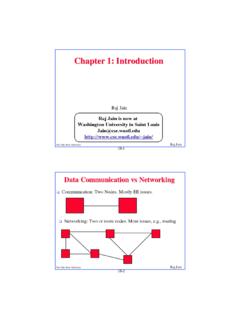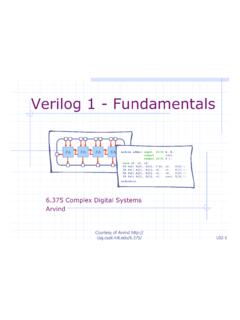Transcription of Big Data Fundamentals - Washington University in St. Louis
1 10-1 2013 Raj ~jain/cse570-13/ Washington University in St. LouisBig DataBig data Fundamentals Fundamentals Raj Jain Washington University in Saint Louis Saint Louis , MO 63130 slides and audio/video recordings of this class lecture are at: ~jain/cse570-13/ .10-2 2013 Raj ~jain/cse570-13/ Washington University in St. LouisOverviewOverview1. Why big data ?2. Terminology3. Key Technologies: Google File System, MapReduce, Hadoop4. Hadoop and other database tools5. Types of DatabasesRef: J. Hurwitz, et al., big data for Dummies, Wiley, 2013, ISBN:978-1-118-50422-210-3 2013 Raj ~jain/cse570-13/ Washington University in St. LouisBig DataBig data data is measured by 3V's: Volume: TB Velocity: TB/sec.
2 Speed of creation or change Variety: Type (Text, audio, video, images, geospatial, ..) Increasing processing power, storage capacity, and networking have caused data to grow in all 3 dimensions. Volume, Location, Velocity, Churn, Variety, Veracity (accuracy, correctness, applicability) Examples: social network data , sensor networks, Internet Search, Genomics, astronomy, ..10-4 2013 Raj ~jain/cse570-13/ Washington University in St. LouisWhy big data Now?Why big data Now?1. Low cost storage to store data that was discarded earlier2. Powerful multi-core processors3. Low latency possible by distributed computing: Compute clusters and grids connected via high-speed networks4.
3 Virtualization Partition, Aggregate, isolate resources in any size and dynamically change it Minimize latency for any scale5. Affordable storage and computing with minimal man power via clouds Possible because of advances in Networking 10-5 2013 Raj ~jain/cse570-13/ Washington University in St. LouisWhy big data Now? (Cont)Why big data Now? (Cont)6. Better understanding of task distribution (MapReduce), computing architecture (Hadoop), 7. Advanced analytical techniques (Machine learning)8. Managed big data Platforms: Cloud service providers, such as Amazon Web Services provide Elastic MapReduce, Simple Storage Service (S3) and HBase column oriented database. Google BigQuery and Prediction Open-source software: OpenStack, PostGresSQL10.
4 March 12, 2012: Obama announced $200M for big data research. Distributed via NSF, NIH, DOE, DoD, DARPA, and USGS (Geological Survey)10-6 2013 Raj ~jain/cse570-13/ Washington University in St. LouisBig data ApplicationsBig data Applications Monitor premature infants to alert when interventions is needed Predict machine failures in manufacturing Prevent traffic jams, save fuel, reduce pollution10-7 2013 Raj ~jain/cse570-13/ Washington University in St. LouisACID RequirementsACID Requirements Atomicity: All or nothing. If anything fails, entire transaction fails. Example, Payment and ticketing. Consistency: If there is error in input, the output will not be written to the database.
5 Database goes from one valid state to another valid states. Valid=Does not violate any defined rules. Isolation: Multiple parallel transactions will not interfere with each other. Durability: After the output is written to the database, it stays there forever even after power loss, crashes, or errors. Relational databases provide ACID while non-relational databases aim for BASE (Basically Available, Soft, and Eventual Consistency)Ref: 2013 Raj ~jain/cse570-13/ Washington University in St. LouisTerminologyTerminology Structured data : data that has a pre-set format, , Address Books, product catalogs, banking transactions, Unstructured data : data that has no pre-set format.
6 Movies, Audio, text files, web pages, computer programs, social media, Semi-Structured data : Unstructured data that can be put into a structure by available format descriptions 80% of data is unstructured. Batch vs. Streaming data Real-Time data : Streaming data that needs to analyzed as it comes in. , Intrusion detection. Aka data in Motion data at Rest: Non-real time. , Sales analysis. Metadata: Definitions, mappings, schemeRef: Michael Minelli, " big data , Big Analytics: Emerging Business Intelligence and Analytic Trends for Today's Businesses," Wiley, 2013, ISBN:'111814760X10-9 2013 Raj ~jain/cse570-13/ Washington University in St. LouisRelational Databases and SQLR elational Databases and SQL Relational Database: Stores data in tables.
7 A Schema defines the tables, the fields in tables and relationships between the two. data is stored one column/attribute SQL (Structured Query Language): Most commonly used language for creating, retrieving, updating, and deleting (CRUD) data in a relational databaseExample: To find the gender of customers who bought XYZ:Select CustomerID, State, Gender, ProductID from Customer Table , Order Table where ProductID = XYZO rder NumberCustomer IDProduct IDQuantityUnit PriceOrder TableCustomer IDCustomer NameCustomer AddressGenderIncome RangeCustomer TableRef: 2013 Raj ~jain/cse570-13/ Washington University in St. LouisNonNon--relational Databasesrelational Databases NoSQL: Not Only SQL.
8 Any database that uses non-SQL interfaces, , Python, Ruby, C, etc. for retrieval. Typically store data in key-value pairs. Not limited to rows or columns. data structure and query is specific to the data type High-performance in-memory databases RESTful (Representational State Transfer) web-like APIs Eventual consistency: BASE in place of ACID10-11 2013 Raj ~jain/cse570-13/ Washington University in St. LouisNewSQLNewSQL DatabasesDatabases Overcome scaling limits of MySQL Same scalable performance as NoSQL but using SQL Providing ACID Also called Scale-out SQL Generally use distributed : 2013 Raj ~jain/cse570-13/ Washington University in St. LouisColumnar DatabasesColumnar Databases In Relational databases, data in each row of the table is stored together: 001:101,Smith,10000; 002:105,Jones,20000; 003:106,John;15000 Easy to find all information about a person.
9 Difficult to answer queries about the aggregate: How many people have salary between 12k-15k? In Columnar databases, data in each column is stored together. 101:001,105:002,106:003; Smith:001, Jones:002,003; 10000:001, 20000:002, 150000:003 Easy to get column statistics Very easy to add columns Good for data with high variety simply add columnsIDNameSalary101 Smith10000105 Jones20000106 Jones15000 Ref: 2013 Raj ~jain/cse570-13/ Washington University in St. LouisTypes of DatabasesTypes of Databases Relational Databases: PostgreSQL, SQLite, MySQL NewSQL Databases: Scale-out using distributed processingNon-relational Databases: Key-Value Pair (KVP) Databases: data is stored as Key:Value, , Riak Key-Value Database Document Databases: Store documents or web pages, , MongoDB, CouchDB Columnar Databases: Store data in columns, , HBase Graph Databases: Stores nodes and relationship, , Neo4J Spatial Databases: For map and nevigational data , , OpenGEO, PortGIS, ArcSDE In-Memory Database (IMDB): All data in memory.
10 For real time applicationsCloud Databases: Any data that is run in a cloud using IAAS, VM Image, DAAS10-14 2013 Raj ~jain/cse570-13/ Washington University in St. LouisGoogle File SystemGoogle File System Commodity computers serve as Chunk Servers and store multiple copies of data blocks A master server keeps a map of all chunks of files and location of those chunks. All writes are propagated by the writing chunk server to other chunk servers that have copies. Master server controls all read-write accessesRef: S. Ghemawat, et al., "The Google File System", OSP 2003, SpaceBlock MapMaster ServerReplicateWriteChunk ServerChunk ServerChunk ServerChunk Server10-15 2013 Raj ~jain/cse570-13/ Washington University in St.















